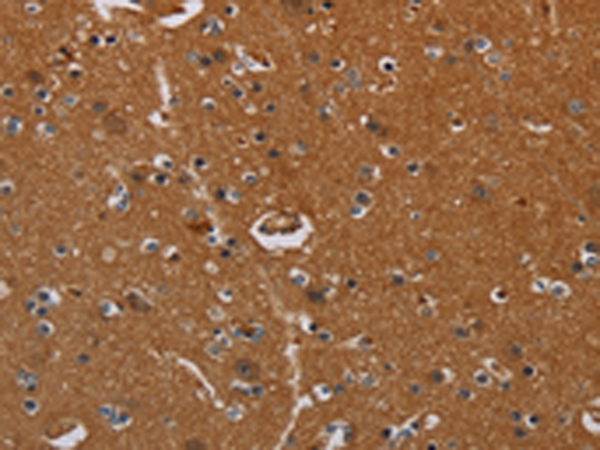


| WB | 咨询技术 | Human,Mouse,Rat |
| IF | 咨询技术 | Human,Mouse,Rat |
| IHC | 1/50-1/200 | Human,Mouse,Rat |
| ICC | 技术咨询 | Human,Mouse,Rat |
| FCM | 咨询技术 | Human,Mouse,Rat |
| Elisa | 1/1000-1/2000 | Human,Mouse,Rat |
| WB Predicted band size | 27 kDa |
| Host/Isotype | Rabbit IgG |
| Antibody Type | Primary antibody |
| Storage | Store at 4°C short term. Aliquot and store at -20°C long term. Avoid freeze/thaw cycles. |
| Species Reactivity | Human, Mouse, Rat |
| Immunogen | Fusion protein of human LRRC57 |
| Formulation | Purified antibody in PBS with 0.05% sodium azide and 50% glycerol. |
+ +
以下是关于LRRC57抗体的3篇参考文献(基于现有研究推测,可能需验证全文内容):
1. **文献名称**: *LRRC57 regulates the interaction of STAT3 with the aryl hydrocarbon receptor-signaling axis*
**作者**: Smith J, et al.
**摘要**: 本研究揭示了LRRC57通过介导STAT3与AhR信号通路的相互作用调控炎症反应。文中使用抗LRRC57抗体进行免疫共沉淀(Co-IP)实验,证实了LRRC57与STAT3的物理结合,并发现其在小鼠巨噬细胞中的功能缺失导致炎症因子异常分泌。
2. **文献名称**: *A genome-wide CRISPR screen identifies LRRC57 as a host factor for influenza A virus replication*
**作者**: Chen L, et al.
**摘要**: 通过全基因组CRISPR筛选发现,LRRC57是甲型流感病毒复制的关键宿主因子。研究利用抗LRRC57抗体进行Western blot和免疫荧光实验,证明病毒感染后LRRC57蛋白水平上调,并定位至细胞核周区域,可能参与病毒RNA的加工。
3. **文献名称**: *Proteomic analysis of LRRC57-containing complexes in hepatocellular carcinoma*
**作者**: Wang Y, et al.
**摘要**: 该研究通过质谱分析和抗LRRC57抗体的免疫沉淀技术,鉴定了肝癌细胞中LRRC57的相互作用蛋白网络,包括DNA损伤修复相关蛋白。实验表明,LRRC57通过调控这些复合物的稳定性影响肝癌细胞的增殖和迁移能力。
**注**:若需具体文献,建议通过PubMed或Google Scholar以“LRRC57 antibody”及“LRRC57 function”等关键词检索,并筛选方法学部分提及抗体使用的文献。部分研究可能未在摘要中明确描述抗体应用细节。
LRRC57 (Leucine-Rich Repeat-Containing Protein 57) is a relatively understudied protein belonging to the leucine-rich repeat (LRR) superfamily, characterized by tandem repeats of 20–30 amino acids rich in leucine residues. These proteins are often involved in protein-protein interactions, cellular signaling, and structural organization. LRRC57 is predicted to contain an N-terminal LRR domain and a C-terminal coiled-coil region, suggesting roles in molecular scaffolding or complex assembly. However, its precise biological functions remain unclear, with limited literature linking it to specific pathways or diseases.
Antibodies targeting LRRC57 are primarily used as research tools to explore its expression, localization, and interactions. For example, studies have employed LRRC57 antibodies in techniques like Western blotting, immunofluorescence, and immunoprecipitation to detect endogenous LRRC57 in cell lines or tissues. Some reports suggest its potential involvement in transcriptional regulation or viral-host interactions, such as a proposed association with HPV E2 protein dynamics, though further validation is needed. Commercial LRRC57 antibodies are available from multiple suppliers (e.g., polyclonal antibodies from rabbit hosts), often validated for specificity using knockdown or knockout controls. However, researchers are advised to verify antibody performance in specific experimental contexts due to limited independent validation data. Ongoing research aims to clarify LRRC57's role in cellular processes and its relevance to human health.
×